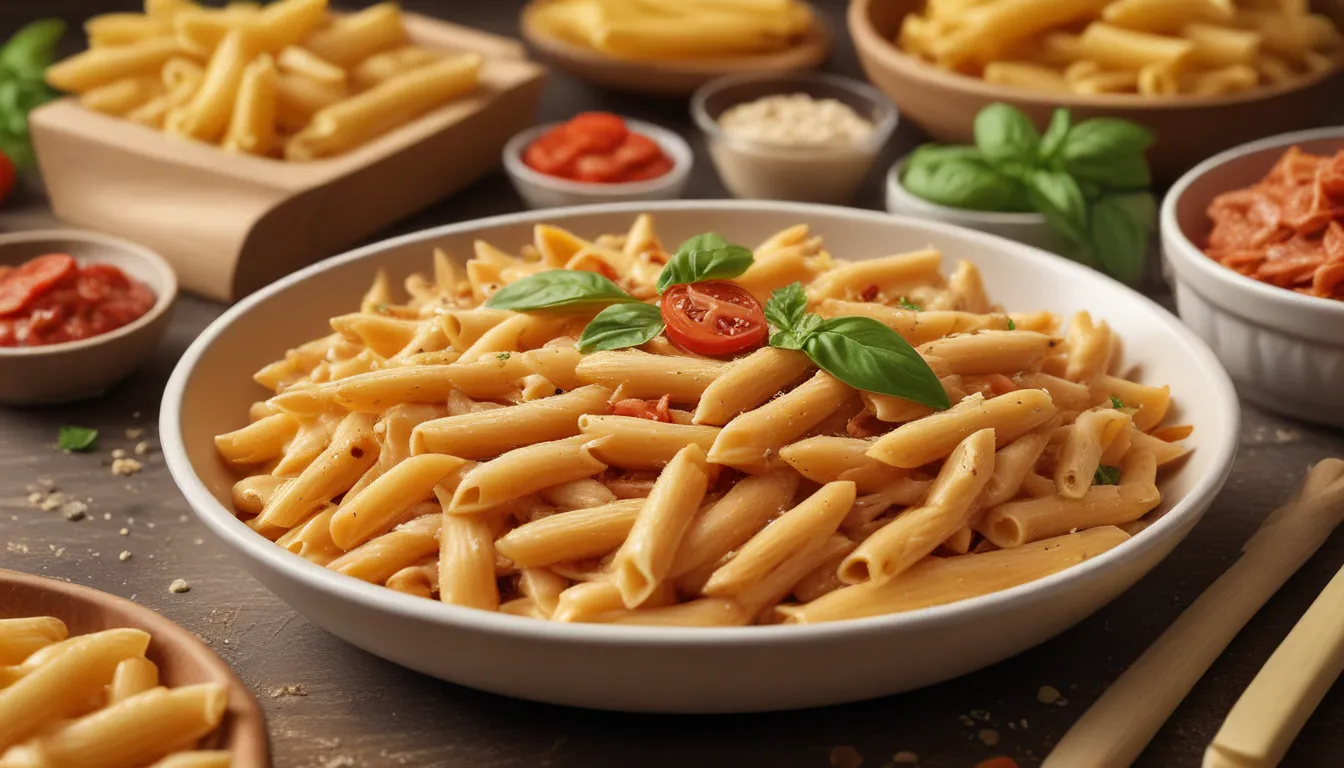The pictures in our articles might not always show exactly what the text is talking about. We use these images to make the article more interesting and eye-catching. They are there to add to the text, but not to replace it or show every detail.
Welcome to a delightful exploration of 19 penne pasta nutrition facts! Penne pasta, a beloved staple in Italian cuisine, is cherished by pasta enthusiasts around the globe for its tubular shape and versatile nature. Beyond its culinary charm, understanding the nutritional aspects of penne pasta can greatly impact your dietary choices. Whether you seek to elevate your pasta dishes or make informed decisions about your nutrition, this article aims to provide valuable insights into the nutrient profile of penne pasta. So, let’s embark on a journey to uncover the surprising nutritional benefits of this cherished pasta variety.
The Wholesome Nature of Penne Pasta:
- Penne pasta is a moderate-calorie, high-carb dish with low fat and sodium content, making it a versatile, filling, and nutrient-rich option for meals.
- With its slow-digesting carbs, fiber, and essential vitamins, penne pasta proves to be a satisfying and healthy choice suitable for individuals of all ages.
- Its accessibility, ease of preparation, and meal prepping convenience further underscore the appeal of penne pasta as a wholesome addition to your culinary repertoire.
Exploring the Nutritional Profile of Penne Pasta:
Calories
One cup of cooked penne pasta boasts approximately 200 calories, making it a balanced and satisfying choice for a fulfilling meal.
Carbohydrates
Rich in carbohydrates, penne pasta provides around 40 grams per serving, serving as the body's primary source of energy.
Protein
Surprisingly, penne pasta contains about 7 grams of protein per serving, essential for tissue building and repair within the body.
Fiber
With each serving offering around 2 grams of dietary fiber, penne pasta supports digestion and promotes a healthy digestive system.
Fat
Low in fat, with less than 1 gram per serving, penne pasta proves to be an excellent option for individuals mindful of their fat intake.
Sodium
Boasting a low sodium content of approximately 5 milligrams per cup, penne pasta emerges as a favorable low-sodium food choice.
Vitamins and Minerals
Penne pasta serves as a notable source of essential vitamins like niacin and folic acid, along with vital minerals such as iron and magnesium, crucial for sustaining bodily functions.
Health Benefits and Versatility:
- Studies have shown that whole grain penne pasta, rich in antioxidants, can aid in protecting the body against oxidative stress and chronic diseases.
- For individuals with gluten sensitivities, gluten-free penne pasta options crafted from alternative grains like rice or quinoa are readily available.
Culinary Appeal and Practicality:
- Penne pasta's versatility allows for seamless pairing with various sauces, vegetables, and proteins, facilitating the creation of a diverse array of delectable dishes.
- Its high carb and fiber content contribute to satiety, controlling appetite and preventing overeating, while also making it a suitable option for meal prepping.
More on Penne Pasta:
- Originating from Italy, penne pasta plays a pivotal role in a myriad of Italian dishes, ranging from pasta salads to baked casseroles.
- With a cooking time of 10-12 minutes and a long shelf life when dried, penne pasta stands out as a convenient pantry staple ideal for quick and easy meal preparations.
Conclusion:
In conclusion, penne pasta emerges as a versatile and nutritious culinary option, offering a good source of energy through complex carbohydrates and essential nutrients like fiber, protein, and iron. While savoring penne pasta, it is crucial to be mindful of portion sizes and opt for nutrient-dense toppings and sauces to optimize its health benefits. Embrace the wholesome goodness of penne pasta as part of a balanced diet!
Frequently Asked Questions:
-
Is penne pasta gluten-free?
Traditional penne pasta contains gluten, but gluten-free alternatives crafted from ingredients like rice or quinoa cater to individuals with gluten sensitivities. -
Are there health benefits to eating penne pasta?
Indeed, penne pasta offers complex carbohydrates for energy, fiber, protein, and essential minerals like iron. Balancing portion sizes and pairing with nutritious toppings is key. -
How many calories are in a serving of penne pasta?
On average, a one-cup serving of cooked penne pasta contains around 200-220 calories, subject to brand and preparation methods. -
Can penne pasta be part of a weight-loss diet?
When consumed in moderation and paired with light sauces and vegetable-rich toppings, penne pasta can certainly be included in a weight-loss diet. -
How should penne pasta be stored?
To maintain freshness, store penne pasta in a cool, dry place within an airtight container to prevent moisture absorption and spoilage.
Whether you're a pasta aficionado or embarking on a culinary journey, embrace the delightful and nutritious essence of penne pasta. Revitalize your meals with this versatile culinary gem and savor its wholesome qualities in each delectable bite!






